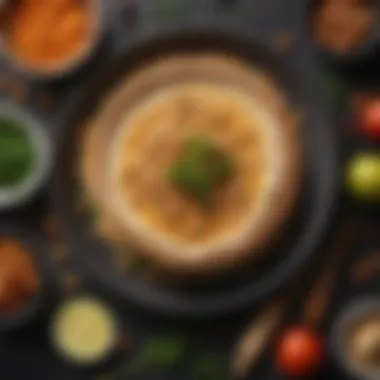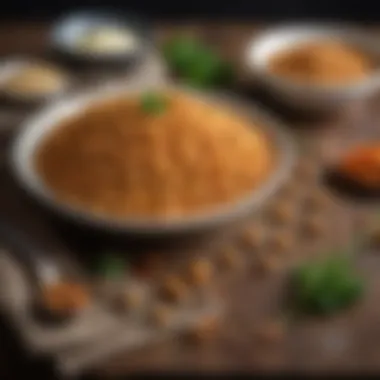Exploring the Complex Flavor of Chickpeas


Intro
Chickpeas stand as a cornerstone in numerous culinary traditions, celebrated not only for their nutritional punch but also for their unique flavor profile. Nestled between the realms of legumes, these versatile gems have a taste that is intriguing yet subtle, allowing them to shine in the limelight or play a supporting role on your plate. They're often described as creamy and nutty, with a mild earthiness that provides an excellent backdrop for a variety of spices and other ingredients.
Once you dive into the world of chickpeas, it’s easy to see why they have captured the hearts of food enthusiasts around the globe.
In this exploration, we aim to peel back the layers of chickpea flavor. Much like peeling an onion, there's more beneath the surface. We will discuss the possibilities chickpeas offer, explore varied cooking methods, and introduce a range of chickpea-centric recipes from several cultures. But the adventure does not stop there; we’ll also look at how modern culinary trends are embracing chickpeas, broadening their appeal, and showcasing their adaptability.
By the end of this guide, you will not only understand the nuances of chickpea taste but also how to fold them into your favorite dishes for an added touch of flavor and nutrition. So, grab your apron, and let's embark on this flavorful journey together.
Preamble to Chickpeas
Chickpeas, often regarded as one of the foundational ingredients in a multitude of dishes worldwide, deserve a thorough introduction. Not just a staple food, chickpeas offer a glimpse into various cultures, histories, and dietary practices. From their adaptability across cuisines to their rich nutrient profile, understanding chickpeas helps one appreciate their culinary significance.
History and Origin
The chickpea, or Cicer arietinum, has a history that stretches back thousands of years. Originally cultivated in the Middle East, archaeological findings suggest that chickpeas were among the earliest domesticated pulse crops. They were used not just for sustenance, but their versatility allowed various societies to create a range of dishes, from hearty stews to delicate salads.
From the ancient Egyptians to the Romans, many civilizations have embraced chickpeas, recognizing their nutritional value and flavor qualities. In fact, they’re well-documented in historical texts as a preferred food source during times of scarcity, attesting to their importance. They were even mentioned in the Bible and other ancient scriptures, underlining their significance over generations.
==Chickpeas found their way into European kitchens, particularly in Mediterranean regions, by the time of the Roman Empire. Following this, they became popular in regions of South Asia and North Africa, where the flavor combinations began to blossom with the introduction of spices, herbs, and misadventures in culinary experimentation.==
Nutritional Profile
Chickpeas are often lauded for their nutritional prowess. They hold a commendable position as a nutrient-dense food item, contributing to a balanced diet. Here are some key nutrients found in chickpeas:
- Protein: They are an excellent plant-based protein source, especially valuable for vegetarians and vegans.
- Fiber: High in dietary fiber, chickpeas aid in digestion and contribute to satiety, which can help in weight management.
- Vitamins and Minerals: Chickpeas are rich in several vitamins and minerals, such as iron, magnesium, and folate. These nutrients play diverse roles, from supporting energy levels to promoting bone health.
- Low Glycemic Index: Their low glycemic index makes them a suitable choice for people managing blood sugar levels.
- Healthy Fats: Chickpeas contain a small amount of healthy fats, including unsaturated fatty acids important for heart health.
"Incorporating chickpeas into your diet isn’t just a boon for flavor; it’s practically a nutritional jackpot!"
Understanding Chickpea Flavor
The spectrum of chickpea flavor is a topic that deserves careful unpacking. While many may see chickpeas simply as a protein-rich ingredient to throw into salads and stews, there’s much more to their, well, flavor. These tiny legumes pack an extensive range of flavors and textures, each influencing culinary possibilities. Understanding the intricate flavor profile of chickpeas allows cooks—from novices to culinary wizards—to maximize their dishes’ potential.
Chickpeas have become increasingly popular in recent years, so knowing what they truly bring to the table helps elevate any meal. A deep dive into the flavor nuances not only enhances cooking skills but also enriches appreciation for a food that’s been loved for centuries.
Basic Flavor Components
Chickpeas, in their raw and cooked forms, present a subtle, nutty flavor. This nuttiness is often accompanied by a creamy texture, making them versatile in both wholesome and richly spiced dishes. The basic flavor consists of three main components:
- Nutty: This dominant feature comes through in various preparations, invoking warmth and comfort in dishes.
- Earthy: A grounding taste that pairs well with a variety of herbs and spices.
- Slightly Sweet: When cooked, a hint of sweetness emerges, providing a lovely contrast to savory elements
These components contribute to chickpeas' ability to blend seamlessly into multiple cuisines, effectively absorbing surrounding flavors while also standing their ground.
Variations Among Different Types
Chickpeas aren't just one flavor; they come in different varieties, each with distinct characteristics. Understanding these variations can unlock new culinary avenues.
Desi Chickpeas
Desi chickpeas, small and dark, originate from India. They pack a punch flavor-wise, with a more textured and nuttier profile compared to their larger counterparts. They are especially favored in Southern Asian cuisines, where they serve as a backbone for hearty dishes. One key characteristic is their tendency to hold firmness even after prolonged cooking. This quality makes them ideal for dishes like Chana Masala where texture plays a crucial role. The downside? Their slightly grainy texture might not appeal to every palate.
Garbanzo Beans
Garbanzo beans, or Kabuli chickpeas, are the most common variety found in Western cuisine. They are larger, cream-colored, and have a milder flavor. This variety is frequently found in Mediterranean dishes, such as hummus and salads. Their creamy and buttery flavor makes them an excellent choice for those seeking a less intense flavor. They soak well to attain catching flavors in stews and soups; however, they tend to get mushy if overcooked, which can sometimes result in a less desirable texture.


Green Chickpeas
Green chickpeas, quite the rarity, offer a fresh, bright flavor. They are harvested early, so they retain a unique sweetness and vibrant green color. This variety is increasingly being used in modern recipes, such as fresh salads and dips. The key characteristic is their versatility, being able to shine both when cooked and raw, added to dishes for a pop of color and taste. The disadvantage might be accessibility, as not every grocery store stocks them. While green chickpeas are not as common, their exquisite flavor provides a refreshing take on traditional chickpea dishes.
"Chickpeas may seem simple but understanding their varieties reveals a world of flavors and culinary opportunities."
In understanding chickpea flavor, one unearths the depths of this humble legume’s potential. By knowing the differences among types, you can make informed choices that elevate your cooking far beyond what’s expected.
Culinary Applications of Chickpeas
Chickpeas serve as a cornerstone in many culinary traditions, where their adaptability in recipes tends to shine through. Denser than a rice grain, with a nutty yet subtle profile, they provide not just nutrition but also a hearty foundation for a multitude of dishes. Cooking with chickpeas harnesses their ability to absorb flavors effectively, making them a favorite around the globe. This section highlights their vital role in traditional dishes and modern trends, underscoring their versatility and the culinary creativity that chickpeas inspire.
Traditional Dishes Featuring Chickpeas
Hierbas de Valle (Spain)
Hierbas de Valle is steeped in tradition and a staple of Spanish cuisine, particularly favored in the Valencia region. This dish, which beautifully melds chickpeas with various fresh herbs, embodies the essence of rustic Mediterranean flavors.
One distinct feature of Hierbas de Valle is its emphasis on fresh, locally-sourced ingredients. The key component here is the chickpeas, which not only add a creamy texture but also a robust nutty taste that's amplified by a medley of herbs. It's a comforting dish that's enjoyed among family, often during festivities.
The use of chickpeas in this recipe aligns perfectly with the overall goal of showcasing chickpeas in diverse culinary contexts. The dish is a testament to how simple ingredients can be transformed into something sublime. However, its preparation often requires a lengthy soaking process, which may be considered a disadvantage for the hurried home cook.
Chana Masala (India)
Chana Masala stands as a shining star in Indian cuisine, renowned for its rich and spicy flavor profile. This dish centers around chickpeas simmered with a blend of aromatic spices such as cumin, coriander, and garam masala. It encapsulates the delicate balance between warmth and zest, inviting diners into a world of vibrant tastes.
A key characteristic of Chana Masala is its ability to serve as a versatile meal option. Be it paired with rice, roti, or naan, this dish adapts well to various accompaniments, making it a popular choice in both households and restaurants. The chickpeas provide essential protein, which appeals to vegetarians and meat-eaters alike. One downside can be the lengthy cooking time, especially when preparing from dried chickpeas, though the satisfaction that comes from a well-made dish often outweighs the wait.
Falafel (Middle East)
Falafel has captured the hearts—and taste buds—of food lovers worldwide. This irresistibly crispy snack or meal option is made from ground chickpeas, herbs, and spices, shaped into small balls or patties, and fried to golden perfection. Its delightful crunch on the outside and soft texture inside make it a unique offering that has transcended cultural boundaries.
The standout characteristic of Falafel is its adaptability; it can be enjoyed in countless ways, from pita sandwiches to salad toppings or served simply with tahini sauce. This dish not only offers a delicious way to highlight chickpeas but is also a powerhouse of plant-based protein, making it exceptionally appealing in today’s health-conscious world. However, the frying method can present higher calorie content than other cooking techniques, a consideration for the health-aware eater.
Modern Trends in Chickpea Cooking
In recent years, there has been a notable surge in innovative chickpea-based recipes that cater to evolving tastes and dietary preferences. The rise of veganism and sustainable eating has positioned chickpeas not just as a side ingredient but as a star in their own right.
Some trends include:
- Chickpea Flour: Increasingly, bakers are exploring chickpea flour in bread and pastry recipes, offering gluten-free alternatives with a distinct flavor.
- Chickpea Snacks: Roasted chickpeas, seasoned with a range of spices, have become mainstream as a crunchy snack option, appealing to health-conscious consumers.
- Plant-Based Proteins: Chickpeas are finding their way into meat substitutes, bolstering their status in plant-based cooking. Dishes like chickpea stir-fry and burgers are becoming frequent entries on menus and dinner tables.
In all, chickpeas show immense potential that carries beyond traditional boundaries. Their diverse applications can appeal to a wide range of dietary needs and culinary styles, igniting creativity in kitchens everywhere.
Impact of Cooking Methods on Flavor
Cooking methods play a significant role in how chickpeas express their flavors. Depending on whether you boil, roast, or soak them, the end result can vary vastly in taste and texture. Understanding these techniques not only enhances your ability to prepare chickpeas, but it also opens up a whole world of flavors. This section further dives deep into the specific methods, exploring the benefits, considerations, and flavor profiles they create.
Boiling vs. Roasting
When you boil chickpeas, you’re typically cooking them until soft, which results in a creamy texture with a mildly nutty flavor. Boiling is straightforward; it often involves adding spices and salt in the water to infuse flavors. However, this method tends to result in a blander taste compared to roasting.
Roasting chickpeas, on the other hand, transforms them entirely. The dry heat caramelizes the natural sugars, adding that lovely roasted flavor. Plus, the texture becomes crunchy, giving a delightful contrast in dishes. When you toss roasted chickpeas with spices—think paprika or cumin—it enhances their flavor profile tremendously, creating a snack that's savory and satisfying. You could say roasting brings out the true personality of chickpeas, while boiling is more like a polite introduction.


"Roasting chickpeas at a high temp for around 30-40 mins can give you a crunch that is irresistible!"
Soaking and Its Effects
Soaking chickpeas is a preparatory step that can’t be overlooked. Not only does soaking reduce cooking time, but it also impacts the flavor. By soaking them in water for several hours or overnight, you allow them to absorb moisture, which makes them plumper and enhances their natural taste. Furthermore, soaking can even aid in digestibility, breaking down complex sugars that lead to discomfort.
If you want to add flavor during this step, consider soaking chickpeas in a salted brine or even broth. This enriches their taste from the get-go. When you finally cook them, that infused flavor can elevate your dish significantly. The saying goes, "You reap what you sow," and in this case, it’s true—how you soak your chickpeas is critical.
Incorporating Spices and Herbs
One of the most advantageous aspects of chickpeas is their ability to absorb and complement flavors. This quality makes them the perfect canvas for spices and herbs. Think about how a simple sprinkle of cumin or a dash of coriander can elevate the ordinary to the extraordinary.
When cooking, you might want to experiment with adding herbs or spices during various steps. For instance, adding garlic, rosemary, or thyme to the cooking water lends chickpeas an aromatic touch. Another approach is mixing them with spices during roasting, which can amplify their flavor profile.
Here are some popular spirits to think about:
- Cumin: Adds warmth and earthiness
- Turmeric: Imparts a vibrant color and bold flavor
- Rosemary: A robust, aromatic herb complimenting chickpeas tremendously
In fact, pairing chickpeas with acidic elements, like lemon juice or vinegar, can enhance their natural sweetness, giving a unique flavor burst. Ultimately, it’s all about balance; consider how spices can either override or enhance the chickpea's mildness.
In summary, the methods you choose can significantly impact not only the texture but the very essence of chickpea flavor. By understanding these mechanisms, you can create dishes that truly shine.
Flavor Pairings with Chickpeas
The topic of flavor pairings with chickpeas is vital in understanding their full potential in various dishes. Chickpeas have a unique profile, which can range from creamy to nutty and earthy, making them adaptable to numerous culinary contexts. Recognizing which ingredients complement or contrast with chickpeas is key to elevating the overall flavor experience. When choosing side ingredients, one considers not only taste but also texture, aroma, and the nutritional contribution of the complementary items. This pairing insight enriches dishes and often brings depth that can turn an ordinary meal into an extraordinary feast.
Complementary Vegetables and Grains
Chickpeas pair wonderfully with a variety of vegetables and grains, enhancing their versatility. For instance, spinach and bell peppers add vibrant colors and freshness, while carrots bring sweetness and crunchiness when cooked alongside chickpeas. This combination not only amplifies flavor but also presents an appealing visual contrast on the plate.
When it comes to grains, options like quinoa or bulgur work exceptionally well. Both of them have nutty undertones that harmonize with chickpea's earthiness. The unique textures make for fantastic salads or grain bowls. Additionally, using brown rice introduces a chewy element that’s satisfying.
Here are some examples of suitable vegetable and grain pairings:
- Vegetables:
- Grains:
- Beetroot
- Kale
- Zucchini
- Couscous
- Farro
- Barley
Herbs and Seasonings to Enhance Flavor
To truly bring out the rich taste of chickpeas, selecting the right herbs and seasonings is essential. Using fresh herbs like cilantro or parsley boosts brightness and enhances the dish's freshness. Just a sprinkle can transform an ordinary chickpea salad into a vibrant treat.
Garam masala, a cornerstone in Indian cooking, adds warmth and complexity, often resulting in a well-rounded dish. Similarly, cumin and paprika introduce a smoky depth that pairs remarkably with roasted chickpeas, making them a go-to for snacks or toppings.
Incorporating alliums like garlic or onion is another great strategy. These ingredients can be sautéed prior to adding chickpeas, allowing flavors to meld naturally.
Here is a selection of herbs and seasonings that enhance chickpea's flavor:
- Herbs:
- Seasonings:
- Thyme
- Oregano
- Mint


- Turmeric
- Chili powder
- Lemon zest
By deliberately pairing chickpeas with the right vegetables, grains, herbs, and seasonings, one can create dishes that reflect global culinary traditions while also bringing personal creativity to the table.
Exploring the interplay of flavors not only honors the chickpea's unique taste but truly represents a journey through diverse culinary landscapes.
Innovative Uses of Chickpeas in Modern Cuisine
Chickpeas are more than just a staple food; they are a culinary chameleon that adapts to a variety of modern dishes. The importance of exploring innovative uses for chickpeas in contemporary cuisine lies in the way they can transform traditional recipes and inspire new creations. As tastes and dietary preferences evolve, chickpeas offer an adaptable base that suits everything from vegan diets to gluten-free baking. Not only do they provide nutritional value, they also introduce a unique layer of flavor and texture that can enhance a dish in unexpected ways.
With the world's increasing focus on plant-based diets and sustainable eating, the chickpea's ability to fit into diverse culinary contexts becomes increasingly significant. Their role will only grow as cooks and chefs seek to expand horizons and experiment with flavors.
Chickpea Flour in Baking
Using chickpea flour, also known as besan, in baking opens a world of possibilities. This flour brings a nutty flavor and a slight earthiness to baked goods, enriching them beyond what all-purpose flour can offer. The high protein content in chickpea flour makes it an excellent option for those looking to incorporate more plant-based protein into their diets.
One standout aspect of chickpea flour is its ability to create a gluten-free base for various products. When it comes to pancakes or bread, the use of chickpea flour is particularly interesting. Mix it with ingredients like water, olive oil, and spices to create a delightful Socca, a type of flatbread hailing from Nice, France. Mmm, that crispy, golden hue is hard to resist!
Benefits of Using Chickpea Flour in Baking:
- Provides a unique flavor.
- Adds protein and fiber content to baked items.
- Functions as a gluten-free alternative.
- Versatile in sweet and savory applications.
Chickpea-Based Snacks and Apps
The shift towards healthier snacking has turned the spotlight on chickpea-based snacks, tapping into the growing demand for nutritious yet satisfying options. Roasted chickpeas, for instance, are a fabulous alternative to conventional snacks like chips. They can be seasoned with various spices to create flavors ranging from zesty lime to sweet cinnamon.
Not to forget the surge in popularity for hummus—this creamy concoction is a well-known chickpea dish that has gained global fame. Hummus can be dressed up in countless ways: by adding roasted red peppers, herbs, or even beets for a vibrant output. You can also crumble some feta cheese on top to really elevate its taste.
Another innovative application is incorporating chickpeas into energy balls or protein bars, delivering sustained energy through their fiber content. Some unique snack ideas include:
- Chickpea-based crackers paired with various dips.
- Chickpea salad bites that combine fresh veggies, lemon, and herbs.
- Spiced chickpea dips that are perfect for parties.
Chickpeas are revolutionizing the snacking scene by providing healthier options that don't skimp on flavor.
In both baking and snacking, chickpeas have proven that they aren't just a humble pantry item; they're a powerful ingredient rich with potential. As culinary exploration continues to expand, one thing's for sure—the versatility of chickpeas will remain a key player in the world of food.
Culmination: The Essence of Chickpea Flavor
Chickpeas have nested their way into various cuisines around the globe, not merely as a source of nourishment but as a vital player influencing flavor profiles and dish creations. Recognizing their culinary importance is essential; they serve as more than just a meat alternative or mere filler in recipes. Their earthy notes and unique texture allow them to stand on their own, being utilized in traditional dishes and modern interpretations alike. This article has touched on the factors that shape chickpea flavor, detailing everything from cooking methods to innovative uses in contemporary cuisine. The depth of this article lays a strong groundwork for appreciating chickpeas beyond their conventional roles, opening avenues for adventurous cooks at every skill level.
Recognizing Its Culinary Importance
In various cultural contexts, chickpeas boast a history as rich as their flavor. They have inspired countless recipes spanning continents and generations. For instance, the Hummus enjoyed across Middle Eastern tables, where blending chickpeas with tahini creates a delightful dip, exemplifies the adaptability of this legume. Each region's unique spices and textures tell a story, elevating the humble chickpea to heights often reserved for prized, exotic ingredients.
Culinary versatility showcases chickpeas in numerous dishes:
- Soups and stews for their ability to absorb flavors.
- Salads, lending protein while maintaining a hearty yet light profile.
- Baking, where chickpea flour can replace wheat flour in various recipes, catering to dietary needs while not skimping on flavor.
The conversation around chickpeas is not just about their physical properties, but about the environment they help create in a dish. A well-prepared chickpea can enhance complementing ingredients, drawing out characteristics that transform a mundane meal into an extraordinary one.
Future Trends in Chickpea Usage
As we peer into the future of culinary endeavors, chickpeas are likely to continue their rise within the culinary community. Recent trends indicate an expanded focus on plant-based diets, which positions chickpeas as a key ingredient due to their nutritional density and inherent ability to mimic meat textures.
Potential trends may include:
- Merger of global cuisines, where chefs blend traditional flavors from different cultures with chickpeas as a centerpiece, promoting cross-cultural appreciation.
- Innovation in snack foods, diving into the chickpea snacks market with more varieties like chickpea puffs or roasted chickpea coatings that cater to health-conscious consumers.
- Futuristic cooking techniques, where technology meets tradition, enhancing flavors through methods like sous-vide or fermentation, opening new avenues for exploration.
"Chickpeas are not just a staple; they are the bridge between health, culinary heritage, and avant-garde cooking."
By recognizing their value and trend potential, chefs and home cooks alike can maximize the role of chickpeas, advocating for sustainable, flavorful practices in a rapidly evolving culinary landscape.















